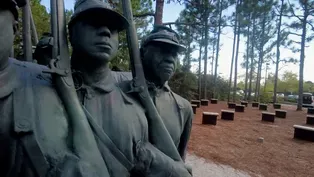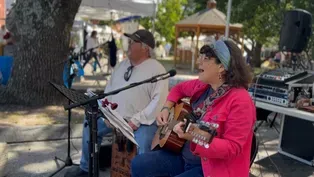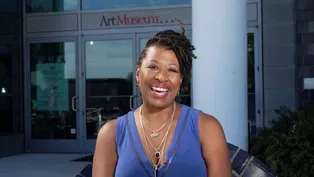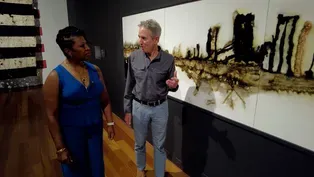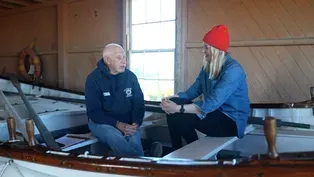
Salt and Seas
Season 22 Episode 6 | 26m 46sVideo has Closed Captions
Travel NC’s coast with stops at historic U.S. Life-Saving Stations and a farmers market in Beaufort.
Travel North Carolina’s magical coast with stops at historic U.S. Life-Saving Stations and a bustling farmers market in Beaufort.

Salt and Seas
Season 22 Episode 6 | 26m 46sVideo has Closed Captions
Travel North Carolina’s magical coast with stops at historic U.S. Life-Saving Stations and a bustling farmers market in Beaufort.
How to Watch North Carolina Weekend
North Carolina Weekend is available to stream on pbs.org and the free PBS App, available on iPhone, Apple TV, Android TV, Android smartphones, Amazon Fire TV, Amazon Fire Tablet, Roku, Samsung Smart TV, and Vizio.
Providing Support for PBS.org
Learn Moreabout PBS online sponsorship[piano intro] - Next on North Carolina weekend, join us from the Cameron Art Museum in Wilmington as we celebrate Salt and Sea.
We'll explore life saving stations on the coast, visit the Beaufort Farmer's Market, and meet artist Thomas Sayre.
Coming up next - [Announcer] Funding for North Carolina weekend is provided in part by Visit NC, dedicated to highlighting our state's natural scenic beauty, unique history, and diverse cultural attractions.
From the Blue Ridge and the Great Smoky Mountains across the Piedmont to 300 miles of barrier island beaches, you're invited to experience all the adventure and charm our state has to offer.
[upbeat music] - Welcome to North Carolina Weekend, everyone.
I'm Deborah Holt Noel, and this week, we're at the Cameron Art Museum in Wilmington.
This museum is a must see for visitors to the Wilmington area.
What began as a modest art museum in downtown Wilmington in the 1960s is now a modern, innovative art space that showcases artists from around the world and close to home.
We'll explore the museum more throughout the show, but first, before the Coast Guard, there was the United States Lifesaving Service, and the year 2024 marks the centennial of this fascinating chapter in our coastal history.
Let's head to the Outer Banks with Rebecca Ward to learn more about our lifesaving legacy in this state.
[waves crashing] - There's 5,000 shipwrecks out there.
Some of them were before there was a lifesaving service, some of them were after.
The graveyard out there might be just the ship.
Our job is not necessarily to save ships, it's our job to save the people.
- [Rebecca] Before the modern US Coast Guard came the United States Lifesaving Service, or the US LSS.
- This isn't just the lifesaving service that became the Coast Guard.
This is America's history.
- [Rebecca] The surfmen who served in the US LSS in North Carolina saved lives in one of the most dangerous maritime regions in the world, nicknamed the Graveyard of the Atlantic.
With little more than wooden boats, ropes, and line throwing guns, North Carolina surfmen risked their lives in severe weather conditions, often in the dead of night to rescue strangers.
- This is not local history, this is national history.
We always tell people it's not just the history of the United States Lifesaving Service and what surfmen did.
You know, all the dots connect, from the Civil War, the fight for freedom, Black watermen.
- [Rebecca] The legacy of the US LSS in North Carolina can be explored underwater and on land.
Let's start at Cape Hatteras National Seashore.
[dramatic music] The history of the US LSS in North Carolina begins in 1874.
When our first seven stations were built along the Outer Banks.
[soft music] - Congress had allocated $200,000 to build some stations in North Carolina.
The superintendent of the lifesaving service was a fellow named Sumner Kimball, and he had targeted the Outer Banks because of the Graveyard of the Atlantic out there.
Chicamacomico is the most complete lifesaving station museum in the United States.
We have an 1874 station.
We have the 1911 station.
Our mission is to preserve the stories of the men who served in the United States Lifesaving Service, and the men who served in the early Coast Guard along the coast of North Carolina.
- So what is the Graveyard of the Atlantic?
- The Graveyard of the Atlantic is the resting place of over 5,000 shipwrecks over the course of history.
- But why right here off the coast of North Carolina?
How is it different than say, anywhere else on the east?
- Couple of different reasons.
One is the weather patterns.
The weather patterns change frequently and quickly.
The other is the clash of the Labrador Current with the Gulf Stream.
They meet out there, which causes the water to swirl and swirl for miles and miles.
The other is shoaling.
- Shoals are natural underwater ridges or banks formed by tides, currents, and waves.
Unlike land, which is a fixed and visible feature, shoals are often hidden beneath the water's surface, and they shift over time.
So Hatteras Lighthouse is built right off the coast of the Graveyard of the Atlantic on Cape Hatteras.
It's over 200 years old, and it's the tallest lighthouse in the United States.
While lighthouses can show where land is, they can't mark underwater hazards or rescue mariners in danger.
- They had built these stations, but then they didn't man them.
To save money, they said we're only gonna man them during hurricane season.
So the Huron, within sight of a station, people drowned, but the station was not open yet.
Thomas Nast, our very famous political cartoonist, drew a cartoon of Uncle Sam hanging his head in shame on the beach with bodies rolling up out of the surf saying, "I guess we're gonna have to spend some money," and then the lifesaving service went 12 months a year.
- [Rebecca] The tragedy of the Huron led to the construction of even more lifesaving stations along our coast, including the Pea Island station.
- Right now, you are on Roanoke Island in Manteo, North Carolina at the Pea Island Cookhouse Museum.
It was the building where people who served in the United States Coast Guard cooked.
The Pea Island station was primarily staffed by Black keepers for 67 years.
My father, Herbert M. Collins, would've been the last left in charge of the station, so he served there the duration of World War II.
His grandfather served at the station, his uncle served at the station.
His great uncle served at the station.
You know, my ties to that station obviously run deep.
This museum honors the history of Richard Etheridge and the Pea Island Lifesavers.
Richard Etheridge was once enslaved.
He was the nation's first Black keeper in the United States Lifesaving Service, and the station that he commanded is the only all Black station in the history of the United States Lifesaving Service.
He ended up fighting in the Civil War for freedom, returning to Roanoke Island, and eventually getting a job with United States Lifesaving Service.
So, you know, his story is also the story of Black watermen, the enslaved who were raised by the water, although they were enslaved, they would've been used to fish, to guide people through these difficult waterways.
You know, they were the experts on the ocean.
It's 1880.
Etheridge is put in charge, and the whites who were at the station, you know, couldn't, wouldn't, didn't, whatever you wanna call it, but that's, you know, that's the start of Etheridge kinda getting an all Black crew.
Then shortly after that, the station is burned to the ground.
There's no one, as I understand it, who was ever accused officially of starting the fire.
In the end, that doesn't stop Etheridge and his crew, you know, this new station is built, you know, they're working with stations, they're doing their thing, participating in joint rescues with other stations, so I think over time, you have men who in these dangerous conditions, you know, would have to respect what each other did.
Above us, here, actually, it's probably, it's our most precious artifact, I think.
You know, this is the actual sign board of the ES Newman.
Keeper Richard Etheridge and the Pea Island Lifesavers are most known for this rescue that occurred October 11th, 1896, in the middle of the night during a hurricane.
- Richard, Captain Etheridge took two of his guys, tied them together and said, you guys swim out to that ship and tell the people to jump off the boat, the ship, and you swim back in with them.
- Swim out, swim out.
And you know, the rescue starts at 9:00 PM and by 1:00 AM, everybody's safely at the Pea Island station.
They never lived to know of any recognition, but thankfully they were posthumously awarded the Gold Lifesaving Medal, and that occurred in March of 1996, almost a hundred years later.
- In 1915, the lifesaving service merged with the revenue cutter service, that's Hamilton's group that's out there collecting tariffs, and they merged and became the Coast Guard.
- What are we sitting in right now?
- We are sitting in surf boat number 1046.
It was the surf boat used in the Merlo rescue.
- [Rebecca] What was the Merlo Rescue?
- The Merlo Rescue was in 1918 in World War I, and there were submarines out there in World War I.
Watch your head.
It's a ladder, not a stairway.
- Okay.
Woo!
- Leroy Midgett was up in that tower.
He was looking out and suddenly he saw a plume of flame and smoke about as high as Hatteras Light, and said, "We got a case."
I see the flare, I know we got a case, I notify the keeper, and we're off.
So they took this surf boat and they launched it into the ocean.
The fourth try, they made it out past the breakers and they saw a lifeboat.
The response from the lifeboat was, "Hi, I'm Captain Williams, captain of the Merlo British Oil Tanker.
I picked up 68 tons of aviation fuel in New Orleans, and the Merlo is hemorrhaging aviation fuel."
We make four trips in, we save 42 of 51 British seamen.
- We're sitting on the boat that those dudes sat on?
- Yeah.
This boat, sat on right up there.
The lifesaving service saved 177,000 people nationwide.
Everybody knew who they were and then they just got forgotten.
Well, we remember 'em here at Chicamacomico, so come on by.
- [Rebecca] To learn more about the history of the United States lifesaving service, you can visit the Pea Island Cookhouse Museum at 622 Sir Walter Raleigh Street in Manteo.
The museum has limited hours, so give them a call at [252] 573-8332 or go online to peaislandpreservationsociety.co.
You can also visit Chicamacomico Life-Saving Station at 23645 North Carolina Highway 12 in Rodanthe.
It's open from 10:00 AM to 5:00 PM Monday through Friday.
Check them out online at chicamacomico.org.
- Right now I'm with sculptor and painter Thomas Sayre, who brought the exhibit Four Walls to the Cameron Art Museum.
So Thomas, each wall represents something different, and I understand this entire exhibit is very personal to you.
- It is.
So three of the four walls, there was some existing work.
For instance, the crosses.
I've been making crosses for 25 years, and I kept adding to the collection, and so this is the first time they've ever been shown, almost all of them in one place.
- [Deborah] What's really special is the materials that you use to create these images.
Talk about the materials for each one.
- Well, I'm known, Deborah, as you know, for digging in the earth and making earth castings where the human hand goes into the ground and collaborates to make this thing which is partially intentional and partially you get what you get, and all these materials are similar.
Smoke, water, burning, burning in various ways, pouring, so these are all, you know, non-art materials generally that I use their properties to create the life of the piece.
Well, this is called Their Solitary Way, which is a short phrase from Milton's "Paradise Lost" which I read when I was 19 as an English major, and during the heavy duty hardcore lockdown, I just started listening to that poem, which is 400 pages, again, and I started kind of illustrating in a way the narrative or some of it.
You know, in the Bible, the story of the fall is half a page and then Milton expands it to 400 pages and makes all this stuff up, and it was permission for me as a visual artist to make a bunch of stuff up.
- Artistic license, I love it.
- But this directly relates to the "Paradise Lost" and the biblical story.
This of course is the tree where the apple was, and in my view, the eating of the apple set in motion the dance of us humans.
You know, we're both godlike and devil-like, and we're not in paradise, and we have to farm our farm as Adam and Eve did when they were kicked out of paradise as we keep going, and they end up as farmers in a hard scrapple farm.
- [Deborah] Tell me about the flag, how that's created and kind of what that's telling people.
- Well, the other three walls have to do with, I mean, "religious" or "sacred" subjects, if you will.
And the fourth wall I felt wanted to be about something a little different.
And you know, the state of our country's on all of our minds, and I was talking to my friend Victor, and we started thinking about how would we represent the flag of America?
And we came up with this burned and charred flag, but behind it, and you can see through it, is a perfect American flag that's completely to federal specifications and color and all that, and you are invited to walk behind or between these two flags, the ideal and the tattered flag, which may say something about where we are now as a country and we, the citizens, are in between adjudicating how we fall on that spectrum of ideal, however you think of that, and where we really are now, - Thomas, this is a very meaningful and powerful exhibit.
Thank you so much for sharing more about it.
- My pleasure, thank you.
- [Deborah] The Cameron Art Museum is at 3201 South 17th Street in Wilmington, and it's open Tuesday through Sunday.
The Thomas Sayre exhibit Four Walls runs through February 16th, 2025.
For more information, give the museum a call at [910] 395-5999 or go to cameronartmuseum.org.
Here at the Cameron Art Museum, they have rotating exhibits, so there's always something new.
Right over my shoulder is a quilt called Sitting at the Feet of Wisdom, and I think it's just beautiful.
You know, when artist Seraphim Smith started a mural in Beaufort, he discovered a thriving outdoor market beneath the live oaks.
Let's get inspired with Seraphim as he takes us on a tour of the Olde Beaufort Farmer's Market.
[upbeat music] - [Seraphim] I'm an artist and I also love baking bread, but I especially love talking with people.
I have a new project coming up, and it's to put a mural on this building, Big Daddy's in Beaufort.
It's an old town which predates the founding of this country by some 67 years.
My task is to create a mural that is fun, funky, and uniquely Beaufort.
I'm on a journey to find inspiration in this pleasant coastal town.
It's full of people who possess a fierce streak of intelligence and creativity.
I'm going to start my exploration at the Olde Beaufort Farmer's Market.
- The farmer's market in Beaufort is really one of the most spectacular events and places that you'll visit while you're in Beaufort.
We meet every Saturday morning from nine o'clock to one o'clock in the afternoon.
- [Seraphim] The farmer's market has about 70 vendors.
It's magical standing beneath these live oak trees.
The resurrection ferns, usually dried and brown, have come back to life this morning after an evening of rain.
There are vendors selling a variety of herbs, vegetables, sustainable seafood and meats, as well as fresh pastries.
It's also a destination for arts and crafts.
There are something here for everyone.
- This market has just been so wonderful and welcoming.
Beaufort is just a well established but embracing community.
Nobody's a stranger here.
- That good?
- That's great.
- All right, you are welcome.
It's my pleasure.
- We are a diverse and vibrant community, so wonderful place to come and visit, live, work, and play.
Welcome to Beaufort.
- [Seraphim] The Arts in Beaufort organization works to beautify the community with art.
Public art activates the imagination, encourages people to pay attention to their surroundings, and stimulates learning thought and conversations about art.
It enhances quality of life.
Public art creates economic growth and it's exciting and generates foot traffic, which benefits surrounding businesses.
There's plenty of fun to be had walking around town.
The boardwalk has great shopping and features dozens of restaurants and boutiques.
Sure, you can find that perfect t-shirt, but why not buy a boat bag made from a recycled boat sail?
You can warm up with espresso or cool down with homemade ice cream.
Surrounded by water, this ocean community naturally has an affinity for watercraft and recreation.
Beaufort has been known as a safe harbor for over three centuries, and the history of Beaufort will have you spinning.
It's alive everywhere you go downtown.
While on the hunt for a mural theme, I'm finding a plethora of plants, a flourishing of flowers, if you will.
In fact, I think I found the inspiration I was looking for.
I'm going to make a mural chock full of native flowers and butterflies.
I've returned to the farmer's market and this time I'm having a big sale to raise funds for the Arts in Beaufort group, and I'm getting the chance to speak with several people in the community.
- They are native plants to this area, and we're going to be adding even more native plants and butterflies.
- [Seraphim] So get on over to Beaufort.
You'll not only enjoy their food, art, and music, but you'll get some inspiration too.
- [Deborah] The Olde Beaufort Farmer's Market is at 402 Broad Street, and it's open on Saturdays from 9:00 AM to 1:00 PM.
For more information, visit their website at oldebeaufortfarmersmarket.org.
Did you know there was an important Civil War battle that was fought right here on the grounds of the Cameron Art Museum?
Last year when I was visiting, I came upon a sculpture by North Carolina artist Steven Hayes, and it tells the story of the US colored troops who fought that battle.
It's called Boundless, and I spoke to curator Daniel Jones about this remarkable exhibit.
So Daniel, tell me a little bit more about the Civil War battle here.
- Yeah, so it was called the Battle of Forks Road, and it was the final battle of the Wilmington campaign before the Union liberates Wilmington and kind of fast tracks the end of the war.
So Wilmington probably didn't start that important, but as all the bigger ports throughout the south got captured like Charleston, Savannah, and New Orleans, that's when all eyes turned towards Wilmington because it was that last major Confederate seaport standing.
So the union put together an offensive to capture Wilmington, but they couldn't just land their soldiers here.
They actually had to go get Fort Fisher about 15 miles south from here at Curry Beach, and from there, those soldiers started marching north towards Wilmington, and this was that final place where the Confederates dug in their last defensive line and then five regiments of USCT fought here for a couple days in February of 1865.
Once they did successfully win this battle, they marched into Wilmington, they liberated, and within about five and a half weeks, Robert E. Lee signs the surrender at Appomattox Courthouse.
- How have visitors responded to this sculpture?
- The support has been overwhelming from young, old, all different backgrounds, ethnicities.
Since this statue has been here for the past couple years, it's really let me know that people want to have these conversations, they just need a place to do it, and that's what this statue serves as.
It kind of creates that dialogue for us.
I quickly learned also that people are way more receptive to talking about these types of local histories when there's a visual aid attached to it.
You know, a piece of art or a performance, dance, singing, poetry, and so as you can kind of see, we've activated the spaces almost like an informal classroom/amphitheater.
So we use Boundless as like a foundation to talk about who we are as a community currently.
We can do that in a plethora ways, so it's not just, you don't have to be a history buff to come like this area.
It's really cool.
You can come out here and listen to music.
You can come out here and watch dance, listen to poetry.
So the reception has just been fantastic.
Support's been great.
- Well, that's it for tonight's show.
We've had a wonderful time here at the Cameron Art Museum in Wilmington, and here they believe that art is not stagnant.
It grows and it grows.
To learn, you work at it with your eyes, your mind, and your heart.
It's a terrific place to visit if you haven't come recently, and if you've missed anything in tonight's show, remember you can always watch us again online at pbsnc.org or find us on our YouTube channel.
Have a great North Carolina weekend everyone.
[upbeat music] ♪ - [Announcer] Funding for North Carolina Weekend is provided in part by Visit NC, dedicated to highlighting our state's natural scenic beauty, unique history, and diverse cultural attractions.
From the Blue Ridge and the Great Smoky Mountains across the Piedmont to 300 miles of barrier island beaches.
You're invited to experience all the adventure and charm our state has to offer.
[upbeat music]
Video has Closed Captions
A public sculpture in Wilmington honors the legacy of the U.S. Colored Troops in the Civil War. (2m 20s)
Video has Closed Captions
Learn all about the Olde Beaufort Farmers Market. (4m 34s)
Video has Closed Captions
Travel NC’s coast with stops at historic U.S. Life-Saving Stations and a farmers market in Beaufort. (27s)
Video has Closed Captions
Explore an exhibition featuring work by artist Thomas Sayre at the Cameron Art Museum in Wilmington. (4m 38s)
Video has Closed Captions
Tour the historic Chicamacomico and Pea Island Life-Saving Stations in the Outer Banks. (12m 5s)
Providing Support for PBS.org
Learn Moreabout PBS online sponsorship